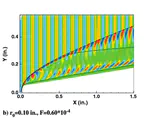Hypersonic Boundary-Layer Stability and Transition to Turbulence

Abstract Prediction and control of the hypersonic boundary-layer transition from a laminar to a turbulent state are vital to developing future hypersonic systems – capable of reaching at least Mach 5, or approximately 3,800 mph.
The boundary-layer transition significantly impacts aerodynamic heating, drag force, and engine performance of highly maneuverable hypersonic systems operating at varying altitudes.
A fully turbulent flow assumption results in an excessive thermal protection system (TPS) weight in the design process. The design tools available to engineers still utilize basic engineering correlations developed from surface measurements of transition locations on wind tunnel models. However, the uncertainty of the transition location can be up to 300%.
Successful prediction and control of boundary-layer transition depend on a fundamental understanding of the underlying physical mechanisms of the hypersonic flow environment.

